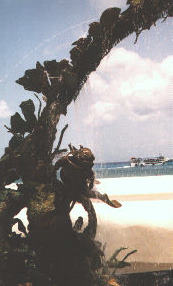Part 3: The Cruise Ship and Cozumel
Introduction: In July and August 1998, the four of us took what was up to that time the most expensive vacation of our lives. This page is Part Three (of eight) of a report on that vacation.
This was all written back in 1998 and 1999. Other than updating links, the text below has not been brought up to date. References to "now" or "soon" or whatever are all as of 1998. Photos have been retouched, but not re-scanned -- the originals were film, not digital, and the scanner used to transfer them back in 1998 wasn't very good.
Note: I haven't bothered repeating the same link over and over, but several may be repeated from one installment of the report to the next. Usually, the first time on each page I mention something that I thought it appropriate to link, I've linked it, but after that it's generally in plain text. A few items are linked more than once; usually (but not always) these links will go different places.
When we'd gotten ourselves safely aboard the Leeward and found our cabins we unpacked a little, got the kids settled to bed -- by this time it was about midnight, and it had been a very long day.
Julie and I were still a bit too wired to go to sleep, though. Instead we went up to the midnight buffet in the Seven Seas dining room on Deck 8, and took a look around the ship.
The buffet was impressive -- huge quantities of food, elegantly displayed. We only nibbled a little, though.
The ship was also impressive. Lots of space of various sorts. The swimming pool was tiny, but nothing else was. (Well, except the bathrooms in our cabins, which were about four feet square, counting the shower stall in the corner.) There was a welcome-aboard party going on in the pool area, but we arrived after the first band had finished and while the second was still setting up, so it was relatively quiet.
The pool is on Deck 9. Deck 10 has the Observation Lounge and piano bar and so on. Deck 11, at the very top, consists of a basketball court.
We looked out over the dock -- there really isn't much there; Calica is not a major port. We watched another busload arrive -- everyone was supposed to be aboard by 11:00, but it didn't happen. One bus driver got lost, we learned later, and the last bus from the airport ran seriously late, as well.
Deck 10, where we watched from, seemed like a long way up. The only light came from the ship; there weren't any lights on the dock, so far as I could see.
It all seemed slightly unreal, actually.
Anyway, after that we decided we'd had enough excitement; we went back to our cabin and went to bed. In theory, the ship was supposed to leave Calica at 4:00 a.m. and reach Cozumel's International Pier by 7:00, so we expected to wake up the next day magically transported to Cozumel and ready to go ashore.
There is something about inside cabins we hadn't given any thought at all. They're dark. Night or day, with the lights off it's pitch-black. There is no way at all to tell whether it's day or night.
So when I woke up on Wednesday, I had no idea what time it was until I found my watch and worked the little light built into it. It could've been any time between 4:00 and 11:00, so far as I could tell.
It was about 8:00, as it happened, so I got up and got dressed, and the commotion woke Julie, and in a few minutes we were all up.
Kiri didn't believe at first that it was really 8:00. "The ship's moving," she pointed out. "We were supposed to be there by 7:00."
She was right -- on both counts. But it really was 8:00; the ship was running well behind schedule due to the boarding delays the night before.
We went to breakfast in our assigned dining room, the Seven Seas -- the "main" dining room (they looked about the same size to me) was the Four Seasons, down on Deck 5. We were shown to a random table -- assigned seating didn't apply at all meals; it always applied at dinner, never at breakfast or the midnight buffet, and lunches were assigned seating at sea, open seating in port -- and given menus, and got our first real on-board meal.
Which was excellent. Food is one thing cruise ships do well.
We could see through the windows that the ship was definitely moving, but it slowed to a stop as we were finishing up, and a series of announcements was made over the ship's P.A.
First off, there was to be a lifeboat drill at 9:00, as required by law.
Second, there had been a change in plans. We would not dock at International Pier, as it was full. Instead we were now anchored off Cozumel, and there would be tender service to the town dock, with boats running every forty minutes or so. This was a bit less convenient, but meant we wouldn't need to pay the taxi fare from International Pier into town. (The pier is three miles south of town.) In the early evening the ship would move over to the pier, once space was available, and everyone must be aboard by 11:30, as we would sail at midnight.
And very shortly after the announcements -- before we had quite finished breakfast, though we were almost done -- the alarm sounded (seven short blasts, one long) and we hurried to our cabins, got our life jackets, and headed to our assigned station (as specified on big obvious signs in the cabins): Lifeboat J, on Deck 5, portside.
Passengers were checked off a list as they reached their stations; the point here was simply to make sure everyone knew where to go. Once we were all there we milled about for awhile as the crew members answered questions ("How much space is there in the lifeboats? How many people can they hold?" "A lot. Far more than we have aboard."). Then we were dismissed.
We went back to the cabins, regrouped, and headed down to Deck 2 to catch a tender.
A tender, for anyone who may not have encountered the term, is more or less a cattle barge for people. They come in various sizes, and tend to be very boxy. The one we used at Cozumel had three decks and could hold a lot of people crammed in -- at least 300, probably much more.
But there's something I should have mentioned that we noticed at breakfast. I mentioned that we had a good view from our table as the ship positioned itself and dropped anchor; I forgot to mention that we could also see International Pier.
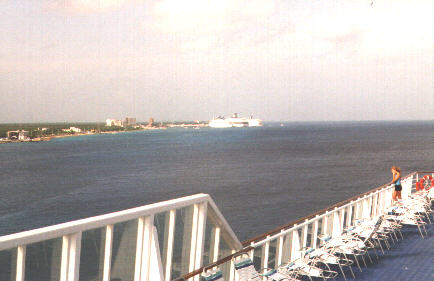 There were three cruise ships docked there, each of them bigger than the Leeward. In fact, one of them was really huge. I had been, as I've mentioned, thinking of the Leeward as big (hey, it's 524 feet long and eleven stories above the waterline -- it is big), but seeing those gargantuan things forced me to revise my opinion somewhat.
There were three cruise ships docked there, each of them bigger than the Leeward. In fact, one of them was really huge. I had been, as I've mentioned, thinking of the Leeward as big (hey, it's 524 feet long and eleven stories above the waterline -- it is big), but seeing those gargantuan things forced me to revise my opinion somewhat.
And once we were on the tender and it pulled away from the Leeward's side, I got a look at yet another cruise ship -- another one had been crowded out at the pier, and had anchored closer in than the Leeward, so that the tender had to putter right past it. ("Putter." I lie. The tender looked like a pile of junk, but there was nothing shabby about its engines, and it didn't putter. It rumbled briskly.)
Right now I forget which ship it was, but it was another big one. I began to realize that for a cruise ship, the Leeward really is kinda puny.
By the way -- the tender had a snack bar and souvenir shop on board, as well as a couple of young men going from bench to bench with an armload of silver necklaces, hawking their wares. It was somewhat more elaborate than a cattle barge.
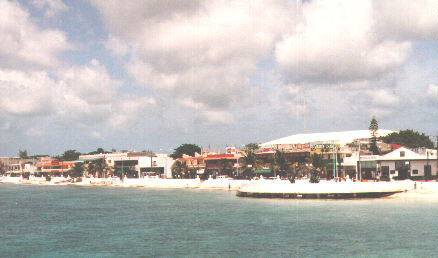 We were safely delivered to the town dock without incident. The center of the dock is taken up by a bar, a snack bar, a souvenir shop, and a tour office -- it's definitely a Mexican tourist trap.
We were safely delivered to the town dock without incident. The center of the dock is taken up by a bar, a snack bar, a souvenir shop, and a tour office -- it's definitely a Mexican tourist trap.
We walked ashore through an arch welcoming us to Cozumel, and found ourselves smack in the middle of town, and again, it was unmistakably tourist country. We could see a Hard Rock Cafe, a Kentucky Fried Chicken, a Carlos 'n' Charlie's, and ten zillion cheap T-shirts.
There was a beach, of sorts, below the seawall, and an abandoned fishing boat -- maybe a sixty-footer -- was washed up on it a little north of the dock. To the north of town we could see the beach curve around and broaden -- if we wanted to swim, that was clearly the place. But we didn't, particularly, as we'd done plenty of swimming in Cancun. Instead we roamed around the town.
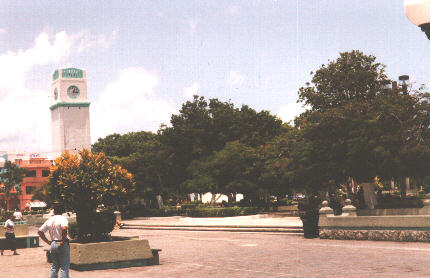 It was something of a disappointment. There's a lovely town square with a clock tower; a ways beyond that there's a church built on the site of the first Catholic mass conducted in Mexico, early in the 16th century. Mostly, though, there are bars and restaurants and shops trying to separate tourists from dollars (and almost everything is priced in dollars, not pesos), and my impression was of a lower-budget version of Cancun, without the fancy hotels.
It was something of a disappointment. There's a lovely town square with a clock tower; a ways beyond that there's a church built on the site of the first Catholic mass conducted in Mexico, early in the 16th century. Mostly, though, there are bars and restaurants and shops trying to separate tourists from dollars (and almost everything is priced in dollars, not pesos), and my impression was of a lower-budget version of Cancun, without the fancy hotels.
It became pretty clear that the town lives off cruise ships. Originally it was a fishing village, and the island was pretty much ignored, until someone realized it was a deep-water port suitable for cruise ships; now they're the basis of the whole economy, it looks like.
We walked around the town, looking at things, admiring the picturesque elements -- there are some, such as the church and the square -- and browsing a few of the shops. We got lunch, I am ashamed to admit, at a Subway -- we didn't see any real restaurants that appealed to a majority of us.
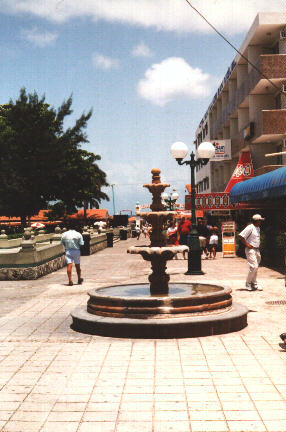 The Subway actually turned out to be interesting, because they had a big TV over the counter, and it was showing a youth sports competition -- the World Youth Games. The sports in question included stuff you never see taken seriously in the U.S. unless they're in the Olympics -- women's soccer, rhythmic gymnastics, walking races, etc. And the major competitors shown were Mexico and Cuba -- the U.S. apparently hadn't entered at all. The competition was taking place in Moscow, I think. Since it was in Spanish, and my Spanish stinks, I'm not entirely sure.
The Subway actually turned out to be interesting, because they had a big TV over the counter, and it was showing a youth sports competition -- the World Youth Games. The sports in question included stuff you never see taken seriously in the U.S. unless they're in the Olympics -- women's soccer, rhythmic gymnastics, walking races, etc. And the major competitors shown were Mexico and Cuba -- the U.S. apparently hadn't entered at all. The competition was taking place in Moscow, I think. Since it was in Spanish, and my Spanish stinks, I'm not entirely sure.
Anyway, after lunch we strolled up the waterfront, poked around on the beach looking for shells (didn't find any good ones), got a good close look at the beached fishing boat, then looked in more shops. Stopped in one rather pleasant place to get a Coke -- they had a bar, resturant, and souvenir shop all in one. They also sold more varieties of tequila than I had known existed -- I was boggled. They had shelf after shelf of tequila bottles, no two the same -- hundreds of linear feet, around two sides of the place.
We didn't buy any, though; we settled for sodas.
The decor was dark tile and wrought iron, by the way, which I liked. Most of Cozumel seems to be built of stucco or adobe in various shades of tan and yellow.
Around mid-afternoon we decided we'd had enough and headed back to the tender. This took us past Carlos 'n' Charlie's, which is a second-floor establishment with one side -- the side facing the sea -- open to the air, with just a railing to keep drunken patrons from tumbling to the street below. It wasn't yet 4:00, and the place was already home to a very loud party.
We missed the tender, and while waiting for the next looked over a rather elegant fountain built out over the seawall, then went on out on the dock and got seats at the snack bar, out of the sun.
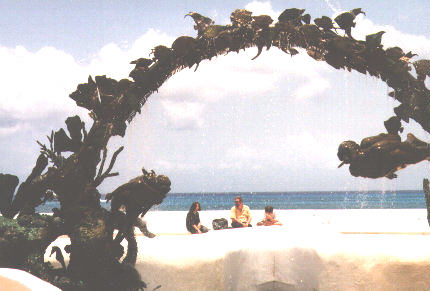 We got the next tender, and on the way out to the ship I realized we could hear the party at Carlos 'n Charlie's until we were about a mile offshore.
We got the next tender, and on the way out to the ship I realized we could hear the party at Carlos 'n Charlie's until we were about a mile offshore.
On the way back we noticed a couple of naval vessels in the area. There is, in fact, a naval base on Cozumel that is, among other things, a major staging area for patrolling along the Belize border and the coast of Quintana Roo, watching out for smugglers and infiltrators. While we were in the area of Cozumel we saw at least three cruisers going about their business.
These are apparently the Mexican Navy's standard all-purpose vessel -- since the navy usually mostly handles smugglers, rescue work, and the like, rather than warfare, they concentrate on these Coast Guard-like craft rather than big warships. These are maybe 100 to 150 feet long -- I'm not a great judge of these things -- and relatively broad of beam, not as sleek as U.S. Coast Guard cutters. They carry just one big deck gun, in a turret near the bow, and have an open deck at the stern suitable for various uses, including as a helipad. They're painted the same ugly grey every navy seems to use, with big white numbers on the side.
It's a real navy, as well as a coast guard -- they've got some serious warships as well as the general-purpose cruisers. We only glimpsed one in the distance, at the Cozumel naval base, while the cruisers were all over the place, but they definitely have bigger stuff. They don't seem to distinguish navy from coast guard because there's no reason for separate command structures, given Mexico's history and geopolitical situation -- they aren't projecting power all over the world the way the U.S. has since at least Teddy Roosevelt's day.
Once we were back on board the Leeward we took a stroll around the deck and noticed one of these cruisers nearby. A man standing at the rail asked, "I wonder what the Navy's doing way down here?"
I pointed out that it was the Mexican Navy, not the American, and he was quite startled -- he apparently hadn't realized Mexico had a navy.
After some recuperation in our cabins, we went up to the dining room to get our supper. As instructed, we brought along our boarding passes -- this was our first dinner on board -- and the maitre d' showed us to Table 61, the table noted on the passes, a table for four on the inboard side of the room not far from the entrance.
The Seven Seas dining room was somewhere between an upscale restaurant and a hotel ballroom in appearance, done in maple and soft green; tables came in all sizes.
 Once we were seated, our waiter, Rodrigo, a big Filipino with a splendid mustache, introduced himself. His territory was a block of just three or four tables -- ours was the smallest -- but he was responsible for seeing to pretty much everything for that block for the entire cruise.
Once we were seated, our waiter, Rodrigo, a big Filipino with a splendid mustache, introduced himself. His territory was a block of just three or four tables -- ours was the smallest -- but he was responsible for seeing to pretty much everything for that block for the entire cruise.
Max, our busboy, was from Costa Rica. Have I mentioned that the Leeward's staff and crew are thoroughly international, coming from at least forty different countries? The captain is Norwegian, the desk staff in the reception area is German, the dealers in the casino are a mix of Romanian, Turkish, British, and Canadian, and so on.
We got our first look at a cruise ship menu. Five-course dinner. We were offered a choice of three cold appetizers, one hot appetizer, three soups, two salads, five entrees (one was listed as "Always Available" -- grilled chicken breast), five desserts, plus a whole separate option of a low-fat, low-sodium dinner that we could choose pieces of... oh, and the cheese board, and the vegetarian entree... All of it included in our fare, as much as we wanted; at one later dinner Julian fell in love with a particular sort of steak and ate three of that entree. I am still astonished that I managed to not gain any weight on the cruise, because we ate a lot, and most of it was very, very good.
The five entrees always included at least one fish, at least one beef, and that grilled chicken -- I think all of us tried the grilled chicken at least once. The food was sometimes fancier than the kids wanted to deal with, but they always found something they liked.
One thing caught us out slightly, though -- beverages. Our regular meals included coffee, tea, milk, and/or fruit juices. Anything else -- soda or wine or beer, for example -- we ordered from the wine steward, who was bar staff, rather than dining room staff, and we signed a chit for it, which went on the bar bill we'd have to pay when we left the ship. This is all part of the on-board credit system, which has got to be a major profit center for the cruise line; we ran up a few hundred dollars in incidentals, and we weren't at all extravagant.
Anyway, while we were eating, the ship lifted anchor -- space had opened up at International Pier, and we were moving down to the dock there. We finished eating in time to go out on the promenade on Deck 5 and watch the docking maneuvers. It takes several honkin' big ropes to secure a cruise ship. They get them in place by first throwing over regular ropes, and those ropes are then used to haul bigger ropes across to the dock, and then those are used to haul the really big ropes, which, when wet, take about three dockhands to haul around.
When I say space had opened up, by the way -- all three of the ships that had been there earlier had left. As we were pulling in we watched the Celebration heading out to sea -- I know it was the Celebration because her name was lit up in huge letters on her superstructure. She's a Carnival ship, holds about 1,600 passengers -- I looked it up. Much bigger than the Leeward. Massive.
(Why are so many cruise ships painted white? The Celebration is completely white, gleaming white from bow to stern.)
The other two, which I never identified, had left earlier, so we had the dock to ourselves, as it were. I vaguely considered going down to set foot on Mexican soil one last time, but didn't bother.
Julie and Julian went back to the cabin, but Kiri and I decided to wander around the ship a bit more, and went up to Deck 10 to see the view. That's where we were when a Mexican cruiser came up and docked directly across from the Leeward, on the other side of the pier.
So Kiri and I watched the Mexican cruiser -- I wish I could remember the name and number; it was C- something, maybe C-14, and the name was long and contained several B's -- tie up directly across from the Leeward. We watched as the crew cleared the decks and set out the gangplank; we watched as a weird-looking military tractor hauled out a big wagonload of supplies from somewhere ashore, which the crew of the cruiser loaded aboard very quickly and efficiently.
 And the fun part was watching the attack helicopter come up from the north and set down on the afterdeck, where it was secured. Told you the Mexican military has aircraft, and that their navy isn't just a coast guard. Turned out the boxy part of the ship's superstructure is a helicopter hanger.
And the fun part was watching the attack helicopter come up from the north and set down on the afterdeck, where it was secured. Told you the Mexican military has aircraft, and that their navy isn't just a coast guard. Turned out the boxy part of the ship's superstructure is a helicopter hanger.
Mexico may not be rich, but it's by no means so backward as the popular image north of the border. Admittedly we were only seeing resorts on this trip, but we saw a thriving economy, lots of healthy, well-fed people, and most of the businesses we dealt with in Cancun or Cozumel were Mexican-owned. (Our hotel was owned by a European chain, and Subway and KFC are American. That's about it.) The cruisers were all in good shape -- at least as spiffy as the German cruiser we saw in the Potomac on a goodwill visit last year, though of course the Mexican ships were in their home waters and hadn't just crossed the Atlantic. We watched the crew of C-14, or whatever it was, and they went about their business very briskly and efficiently -- they knew what they were doing and did it well, from what we saw. Rigging the nettings for the helicopter landing, the various stowings and unstowings, were all done snappily.
When it looked as if the excitement on the cruiser was done Kiri and I retired; I don't remember whether we did anything else that evening, except maybe poke around the ship, seeing what was where. Around 11:30 I went back up to watch our departure -- theoretically everyone was supposed to be aboard by 11:30 for a midnight departure. In practice, people were still drifting in at 11:50, and it looked very unlikely we'd leave on time, so I gave up and went to bed.

This concludes Part Three. Links to the other parts of this trip report are below:

- Planning and Departure.
- Three days in Cancun. (Previous installment)
- Across the Gulf of Mexico..(Next installment)
- Key West
- Great Stirrup Cay
- Port Canaveral and the Kennedy Space Center.
- Charleston, Alexandria, and home.




